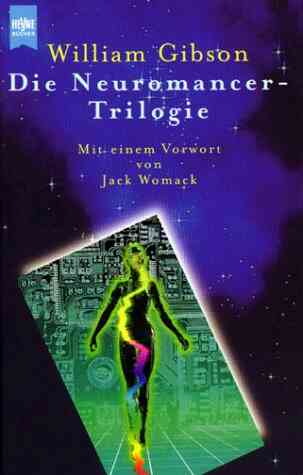|
 Neuromancer has
probably been the single most influential depiction of the future published
during the past thirty years. Gibson's first novel popularized the term
"cyberspace", made computer hacking seem exciting and cheered a generation of
computer science students with the idea that if they wore mirrored sunglasses
and spent a lot of time on-line then they could be cool too. Together with Bruce
Sterling (see below), Gibson self-consciously promoted his work as a new kind of
science fiction -- out to shake up people's ideas of the future. Although Gibson
published two direct sequels to Neuromancer, and has written a number of other
novels, none has had anything like the impact or freshness of this first effort. Neuromancer has
probably been the single most influential depiction of the future published
during the past thirty years. Gibson's first novel popularized the term
"cyberspace", made computer hacking seem exciting and cheered a generation of
computer science students with the idea that if they wore mirrored sunglasses
and spent a lot of time on-line then they could be cool too. Together with Bruce
Sterling (see below), Gibson self-consciously promoted his work as a new kind of
science fiction -- out to shake up people's ideas of the future. Although Gibson
published two direct sequels to Neuromancer, and has written a number of other
novels, none has had anything like the impact or freshness of this first effort.
Read today, the book can seem a little clichéd. As you read it, remember that
the book was written before the Web, before the idea of "virtual reality" was
invented, back in the days when Atari was the hottest technology company and
millions of people were buying home computers to hook up to their television
sets. Gibson inspired a lot of real-life computer people with his idea of
immersive on-line worlds, although his own technology is somewhat fanciful.
(Read closely, and you'll notice some slips and a lot of early-80s assumptions).
Discussion Questions
- Gibson's future shares some similarities with Pohl's, but there are some
important differences in both the world itself and the aspects of it that the
two authors choose to focus on. What are the similarities and differences?
- One of the important differences between this story and many of the others
we read is in the relationship of its characters to the technologies they are
dealing with. How is it different? How do the characters themselves differ?
- Gibson borrows ideas and plot elements from all over the place -- both
science fiction and non-science fiction. As you read the book, try and
identify familiar sources (authors, types of book or film) and elements.
- How realistic is the technology presented here? Would you saw that he was
very familiar with the computer and network technologies of 1982? Does it
matter?
- Unlike most of the other authors, Gibson shows the reader a future
containing several different sub-cultures, all of them descending from
existing human cultures. How does he use the Japanese elements, the futuristic
Rastafarians, and so on?
- Molly and the other female characters are striking and sometimes powerful.
Have we finally arrived at an equal-opportunities future?
- What is specifically 80s about Gibson's future? What does it have in
common with Blade Runner?
Resources
 | Paul Brians has produced an interesting
study guide for the book. |
 | The web is full of Gibson sites, but I couldn't find many good ones and a
lot of links seem broken. This
one is pretty good. It includes a scan of a
graphic
novel based on the first third of Neuromancer. You might want to check
the index
to Gibson-related articles in Wired magazine. |
 |
This Cyberpunk site is pretty good, and has some Blade Runner links --
including the script, which may be handy if you want to refer to it in
your papers. (There's also links to two earlier script versions called
7-24-80 and
2-23-81, where
you how some of the stuff that puzzles in the final version was originally
supposed to work. ). |
 | Gibson's other books are worth a look, particularly Mona Lisa Overdrive.
However, his freshest work is found in his collection of short stories,
Burning Chrome.
Many of these predate Neuromancer, and most of them share the same style and
mood. The dazzling style works well in the shorter stories, and Gibson's
construction and plotting is surer here than it was at novel-length. They
turned one of them into the film Johnny Mnemonic, but you can't really hold
that against him. |
 | If I'd had room on the syllabus for one more book, it would have been the
amazing Schismatix
by Bruce Sterling (the other key figure in the cyberpunk movement).
Sterling fuses 1980s cyberpunk concerns and technological ideas with the
themes of human destiny, alien contact and space colonization beloved by the
writers of the 1950s. It hasn't been nearly as influential as Neuromancer, but
it's probably a better book. Epic time-scales, panoramic vistas, cold-war
themes, terraforming, genetic engineering, adventure, and an amazing number of
ideas. Dramatizes the theme of future shock with unmatched power. Also quite
involving as the story of a single human life in a time of constant
technological and social flux, and so ultimately moving in the same kind of
way Arthur C. Clarke and Stapledon sometimes were. |
 | A lot the the issues raised by this book (computer hackers, video games,
home computer technology, virtual reality, etc.) were treated in considerably
more detail in my recent course ST297: Technology & Revolution. You missed it,
but you can still visit out the
links, readings and so on on-line. |
 | The internet is full of things (user names, host names, websites) called
Wintermute. Now you know why. |
|